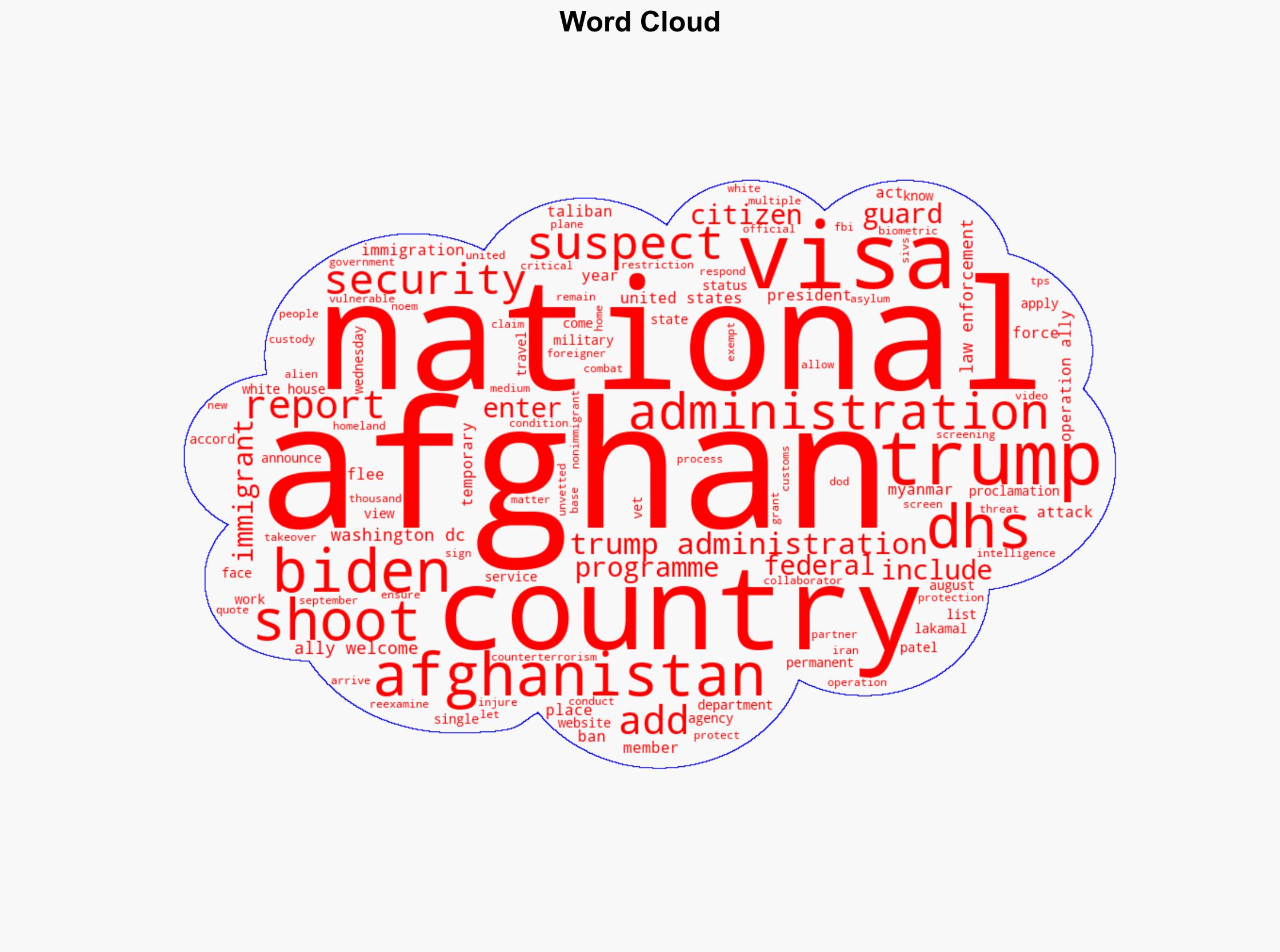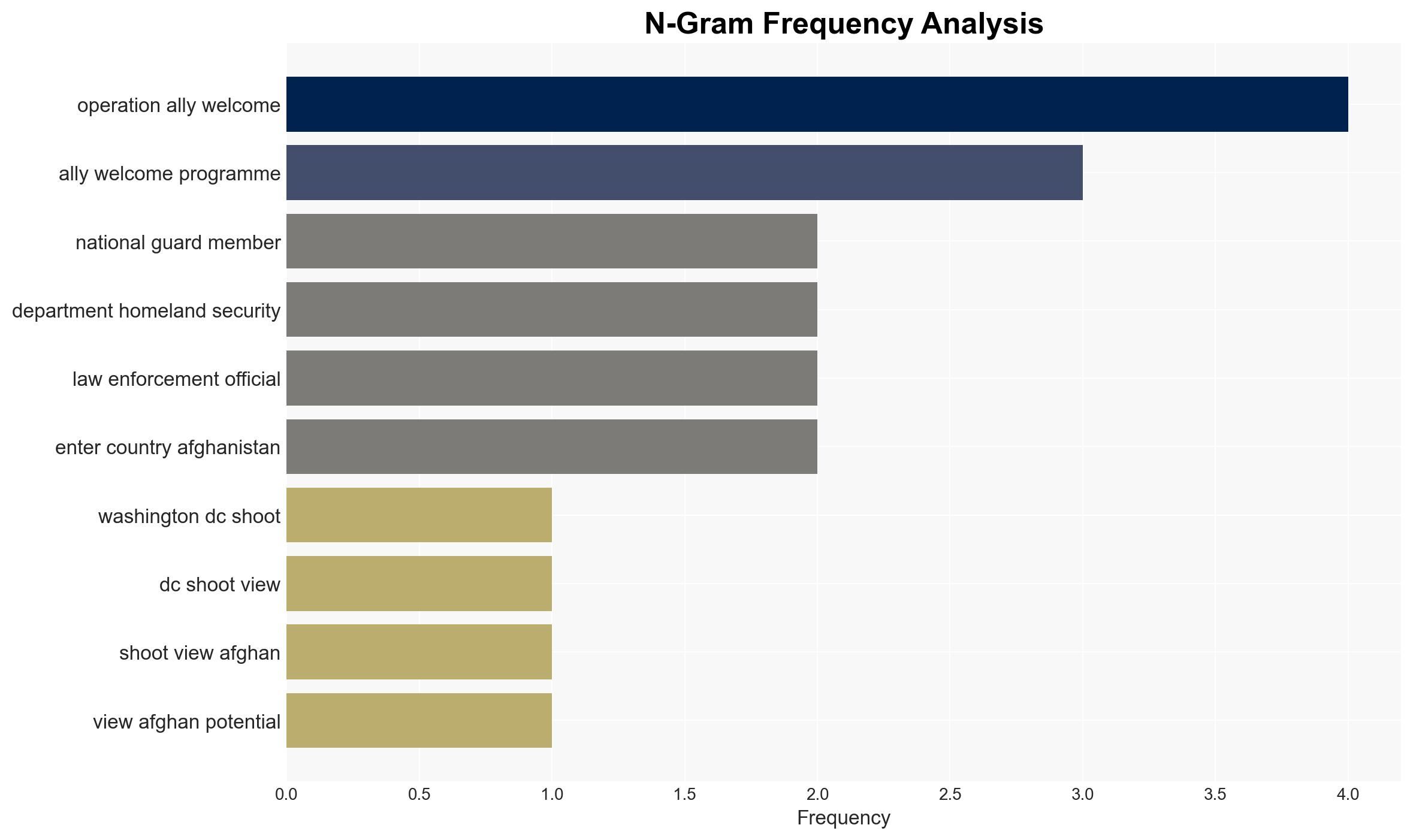Shooting in Washington DC raises concerns over Afghan nationals as potential security threats
Published on: 2025-11-27
AI-powered OSINT brief from verified open sources. Automated NLP signal extraction with human verification. See our Methodology and Why WorldWideWatchers.
Intelligence Report: Washington DC shooting Does US view 77000 Afghans as potential threats
1. BLUF (Bottom Line Up Front)
The shooting incident near the White House involving an Afghan national raises concerns about the vetting processes under the U.S. immigration programs for Afghans. The event has sparked political debate about national security risks associated with Afghan immigrants. The most likely hypothesis is that this incident will lead to increased scrutiny and potential policy changes regarding Afghan nationals in the U.S., with moderate confidence.
2. Competing Hypotheses
- Hypothesis A: The shooting was an isolated criminal act by an individual with no broader implications for Afghan immigrants. Supporting evidence includes the lack of immediate ties to organized terrorism. However, uncertainty remains about the suspect’s motives and background.
- Hypothesis B: The incident reflects broader security risks associated with the influx of Afghan nationals under current U.S. immigration policies. This is supported by political rhetoric and concerns about vetting processes, but lacks concrete evidence linking the suspect to terrorist activities.
- Assessment: Hypothesis B is currently better supported due to the political and security discourse it has generated. Indicators that could shift this judgment include new evidence about the suspect’s affiliations or changes in immigration policy.
3. Key Assumptions and Red Flags
- Assumptions: The suspect acted independently; current vetting processes are insufficient; political responses will prioritize security over humanitarian concerns.
- Information Gaps: Detailed background on the suspect, including potential affiliations; comprehensive data on the vetting process effectiveness.
- Bias & Deception Risks: Potential confirmation bias in interpreting the incident as a broader threat; media and political bias influencing public perception.
4. Implications and Strategic Risks
This development could lead to heightened scrutiny of Afghan immigrants and potential policy shifts. It may also exacerbate political divisions and influence public opinion on immigration.
- Political / Geopolitical: Potential for increased tension between political factions over immigration policy and national security.
- Security / Counter-Terrorism: Possible tightening of security measures and vetting processes for Afghan nationals.
- Cyber / Information Space: Increased misinformation or disinformation campaigns exploiting the incident to influence public opinion.
- Economic / Social: Potential social unrest or backlash against Afghan communities, impacting social cohesion.
5. Recommendations and Outlook
- Immediate Actions (0–30 days): Enhance monitoring of Afghan nationals with unclear backgrounds; review and strengthen vetting processes.
- Medium-Term Posture (1–12 months): Develop partnerships with Afghan community leaders to improve integration and security awareness; assess and adjust immigration policies as necessary.
- Scenario Outlook:
- Best: Incident is isolated, leading to improved vetting without significant backlash.
- Worst: Incident sparks widespread anti-immigrant sentiment and policy overhauls that strain U.S. resources.
- Most-Likely: Incremental policy adjustments with increased scrutiny of Afghan nationals.
6. Key Individuals and Entities
- Rahmanullah Lakanwal (Suspect)
- Department of Homeland Security (DHS)
- Kash Patel (FBI Director)
- Muriel Bowser (Washington Mayor)
- Donald Trump (Former President)
- Joe Biden (President)
7. Thematic Tags
National Security Threats, national security, immigration policy, counter-terrorism, Afghan nationals, political discourse, vetting processes, public safety
Structured Analytic Techniques Applied
- Cognitive Bias Stress Test: Expose and correct potential biases in assessments through red-teaming and structured challenge.
- Bayesian Scenario Modeling: Use probabilistic forecasting for conflict trajectories or escalation likelihood.
- Network Influence Mapping: Map relationships between state and non-state actors for impact estimation.
Explore more:
National Security Threats Briefs ·
Daily Summary ·
Support us





